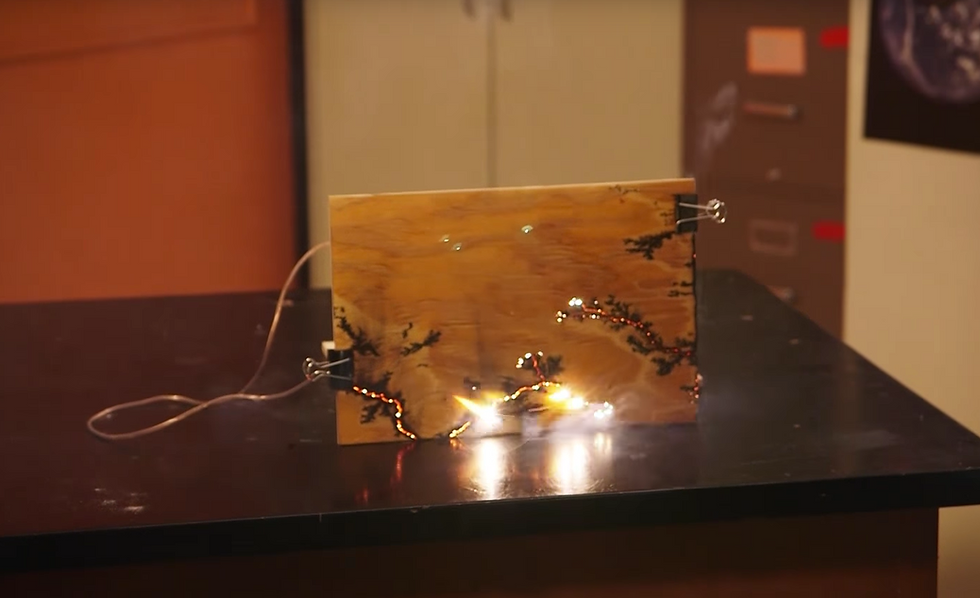Electrifying Experiments - Invisible Labs with Craig Beals
- Craig Beals
- Jan 3, 2016
- 3 min read
Updated: Aug 23, 2021
Imagine your life without electricity. At this point we are so used to having electricity available that it would be hard to live without it. We need electricity to keep food from spoiling in our refrigerator, we need it to stay connected when we charge our cell phones and even some cars run off of electricity. We are a world that is dependent upon electricity and our dependence continues to grow.
Many people don't really understand how electricity works and it can get quite complex but we can boil it down to some very simple concepts. Electricity has to do with electrons, those negative particles that race around the nucleus of an atom. In fact, the movement of electrons is how electricity got its name. Copper is a good conductor of electricity, which means that the copper atoms allow their electrons to easily move from one atom to the next - hence the movement of electrons down the power lines and into your home.
To explore some of the properties of electricity, Quinn Miller (former chemistry student of mine) and I set up a few experiments:
Making a Simple Capacitor with a Plasma Ball Toy and Pennies

One way to explore electricity is to place a stack of pennies on top of a plasma ball. A plasma ball has a cathode (positive electrode) at the center that has an oscillating frequency. The air around the ball allows electrons to stream from the center to the glass "globe" on the outside. As it does, the gas is heated and begins to glow - this is the glowing 'plasma' that you see in the ball (more info here).
A capacitor is something that stores up electrons. Usually this consists of several conductors (in our case these are the pennies) separated by a thin insulator (this is the small air gap between our pennies). Electrons start to build up on the pennies and if you hold another conductor next to the pennies, whether it is another penny or your finger, the electrons will jump from the capacitor to the other conductor, making a tiny "bolt of lightning". But, if you use your finger be careful, it will burn a hold in your skin...I know from experience!
Jacob's Ladder made from a Neon Sign Transformer and Coat Hangers

In high school, Quinn was a savant with electricity. I asked him to build me a Jacob's Ladder Electricity Simulator and within a few days he had one build. The transformer on the bottom the bottom of Jacob's ladder, which was taken from an old neon sign, takes the electricity from plug in the wall and, through several steps, exposes the electricity to several magnetic fields which increases the voltage and the amperage of the electricity.
One side of the transformer is an anode (negative charge) and the other is the cathode (positive charge). The electrons stream up the clothes hanger because it is a conductive metal and they stream across to the other hanger, effectively completing the circuit. The arc of 'plasma' moves upward on the ladder as it heats the air around it - remember hot air rises.
Burning Wood with Electricity and Making Lichtenberg Figures

Microwave Ovens have a high voltage transformer (similar to what is described above) but are capable of producing very high voltage and high amperage. The plywood was first moistened with a saturated mixture of water and baking soda - the baking soda makes the solution conductive. The cathode and anode were attached to opposite ends of the board and the transformer was plugged in. The electricity coursed through the solution which began to heat the wood and burn it.
The electricity follows the path of least resistance and in doing so begins to make fractal like patterns in the wood called Lichtenberg Figures.
Making Glass with Electricity from a Microwave Oven Transformer

Silica sand conducts electricity. Silica sand (buy it here) is also what glass is made of. To make glass, silica sand has to be heated to the melting point and allowed to cool. As it cools it forms into a crystal lattice structure that is transparent.
We poured some silica sand into a plastic bin, ran the cathode (positive wire) was attached to a piece of metal stuck in the sand. We then held the anode (negative or 'ground' end) inside the sand and turned on the electricity. The arc of plasma shot across through the sand and began to heat and melt the sand. As the sand cooled it formed crystals that were transparent - making glass!
For more episodes of Invisible Labs with Craig Beals, click the logo:

Invisible Labs is brought to you by FLIR Systems, visit their website to learn about Infrared Technology and to purchase FLIR gear.





